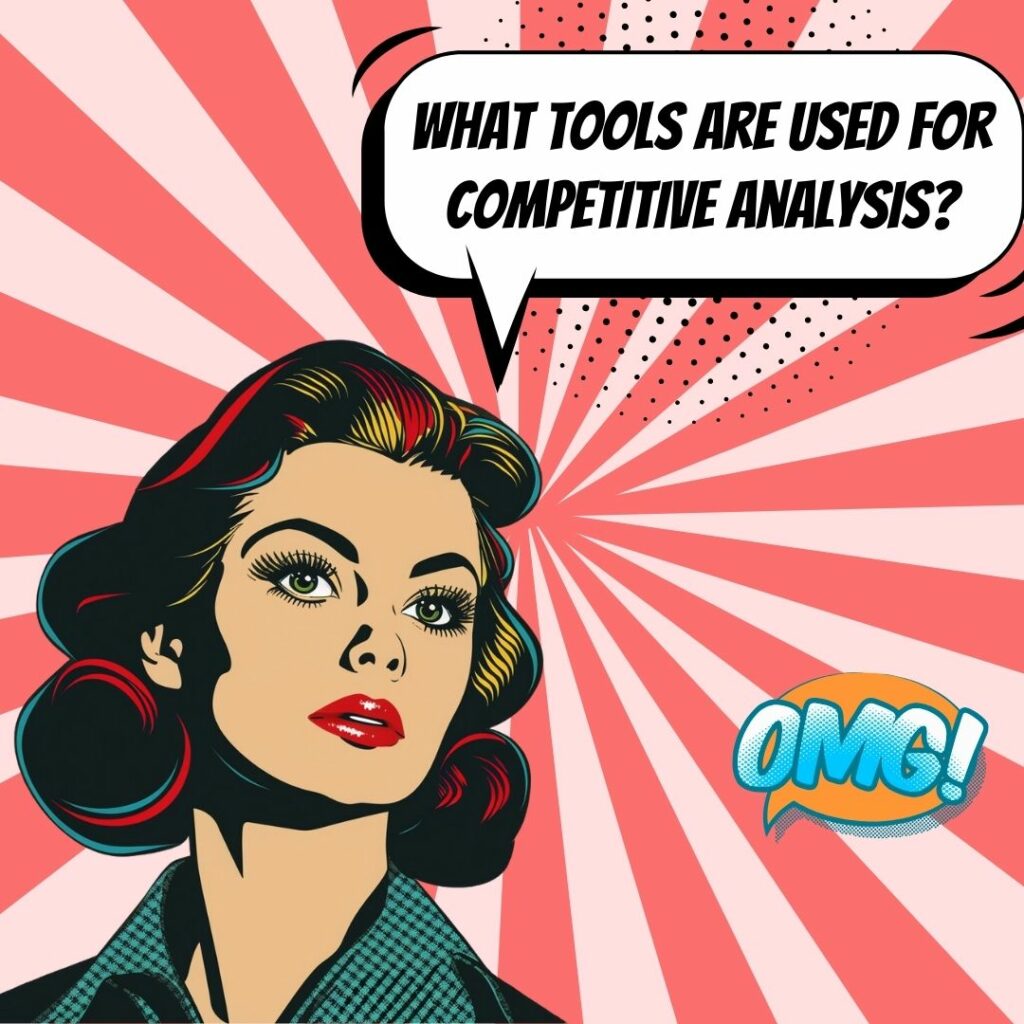Key Takeaways
✅ Identify and Research your Competitors: Begin with a deep dive into who stands against you in the business arena. Look at what they’re offering and how they connect with their customers. It’s not just about products; peek at their marketing flair and customer chatter. Think along the lines of Google snooping, social media stalking, embracing industry whispers, and tuning into the customer grapevine.
✅ Analyze Competitors’ Strengths and Weaknesses: Got your list of rivals? Now it’s showtime to decode their power moves and where they stumble. It’s like game tape—analyze their pricing finesse, how they spread the word, and whether their customers are singing praises or blues.
✅ Develop a Competitive Strategy: Time to take all that spy-worthy info and craft your master plan. Maybe you tweak your prices, add some sparkle to your services, or give your marketing a megaphone. Think of it as a living playbook—always on the move based on what your business opponents are doing.

Introduction
Ever felt like you’re running a race but everyone else has a head start? That’s business without competitive analysis. Know your rivals and not only catch up but zoom past—that’s the name of the game in strategy enhancement.
How about getting the scoop on who you’re up against, sizing them up, and then tweaking your game plan? This isn’t just about survival; it’s your ticket to thriving in the competitive market. We’re talking real steps, no fluff, to edge out the competition and seriously boost your bottom line.
Stay tuned, because we’re about to unravel some of the industry’s best-kept secrets that will skyrocket your ROI and keep you ahead of the curve. Ready to unlock actionable insights and revolutionary strategies? Let’s dive in and start outsmarting the competition together!
Top Statistics
| Statistic | Insight |
|---|---|
| Competitive Intelligence Essentials: 74% of companies consider competitive intelligence crucial for strategic decisions. (Source: Forrester) | Knowing this, aren’t you curious about what insights could be hiding in your competitors’ strategies? |
| Frequency of Analysis: 76% of companies perform competitive analysis at least monthly. (Source: Crayon) | It shows consistent monitoring is a must to stay on top of the game. How often do you check on the competition? |
| Digital Transformation: By 2024, 75% of organizations will make data and analytics a central part of their business. (Source: Gartner) | The inclusion of data and analytics is a clear signal of where future strategies are headed, don’t you think? |
Understanding the Importance of Competitive Analysis
Hey, have you ever wondered why some businesses seem to always be a step ahead? It’s like they have a secret map that shows them exactly where the treasures are hidden. That map, my friend, is called competitive analysis. Imagine you’re a detective; you’re looking for clues on what makes your rivals successful or where they might slip up. Understanding your competitors is like having a cheat sheet for an exam; it can help you make informed decisions and spot opportunities to shine.
Identify Your Competitors
So, how do you figure out who you’re up against? First, get a lay of the land – what’s your industry, and who are you trying to sell to? Then, it’s time to play detective. Who stands between you and your customer? Use every tool at your disposal – Google, Twitter banter, LinkedIn connections. It’s like putting together a list of usual suspects. Recognize not just the known rivals but also the sneaky ones that might not be so obvious. That coffee shop down the street? Yep, they can be a competitor too if you’re both fighting for the same morning crowd.
Analyze Competitors’ Strengths and Weaknesses
Alright, now let’s dig deeper into what makes these competitors tick. What’s in their arsenal – is it a killer product, a rock-bottom price, or charm off the charts? Peek at their game plan – how do they attract customers, and what’s the magnet that keeps them coming back? To get the full picture, break it down with a SWOT analysis: strengths, weaknesses, opportunities, and threats. It’s like being able to see their hand in a poker game, but don’t forget, they can see yours too.
Evaluate Your Own Position
Time to turn the magnifying glass on yourself. What makes you unique – that secret ingredient in your grandma’s recipe, maybe? Do a SWOT analysis for your shop. What’s your ace, and where could you use a little help? Find those cracks in your own game before your competitors do. It’s about knowing your own story just as well as you know theirs.
Benchmarking and Market Trends
You know that feeling when you see someone at a party, and you can’t help but compare outfits? That’s benchmarking. Check out how you measure up against the industry standards. Are you keeping up with the latest market trends? Consumers can be fickle, chasing after the latest shiny thing, and you’ve got to stay hip. Keep an ear to the ground, and an eye on the news – it’s how you stay in the know.
Develop a Competitive Strategy
This is where the fun begins. How can you make your competitors’ weaknesses your comeback story? Find your groove and differentiate your business. Think about how you can be the better deal or the more memorable brand without simply being a copycat. Then, play around with your price tags – can you swing a more tempting offer? This isn’t just about one-upping the other guys; it’s about being the best you.
Monitor and Update Your Analysis
Never let your guard down. The business world moves fast, like a game of musical chairs, and you’ve got to keep up with the beat. Keep an eye on your rivals and dance to the rhythm of industry shifts. Your competitive analysis isn’t a one-time thing; it’s your series – constantly renewing, with fresh episodes of strategies and insights.
Remember, knowing your competitors is a bit like knowing the weather forecast. It helps you prepare for the storm and maybe even enjoy the rain when it comes. Keep this guide in your back pocket, and you’ll be navigating the competitive seas like a seasoned captain.
AI Marketing Engineers Recommendation
Recommendation 1: Identify and Monitor Your Competitors’ Online Presence: Start by listing out who your competitors are – but don’t just stop there. Diving into their digital footprints can uncover a goldmine of information. What social platforms are they using? How do they speak to their customers – is it formal or more laid-back? What kind of content gets the most likes or shares? See, these nuggets of info are like puzzle pieces. Once you put them all together, you can see the bigger picture and find out where there’s room to do things differently or better in your strategy. And hey, there’s a bunch of online tools that can track competitor website traffic and social engagement. Use them!
Recommendation 2: Analyze Competitors’ Customer Reviews and Feedback: Have you ever snooped around to see what customers are saying about your competitors? You should. Think of it as eavesdropping, but the good kind. Customer reviews, forums, and feedback sections are where people spill the beans about what they love or, just as valuable, what they don’t. Current trends show that buyers are looking for authenticity and responsiveness, so pay attention to how your competitors handle both praise and complaints. Let this drive how you communicate with your audience. Do you notice a common complaint? That’s your chance to step up and fill that gap. Be the hero your customers are looking for.
Recommendation 3: Utilize SEO and Keyword Analysis Tools to Understand Market Trends: Okay, it’s not the most glamorous part of marketing, but knowing which keywords your competitors rank for is like having a treasure map. Tools like Google Analytics, Ahrefs, or SEMrush can show you the lay of the land. What products or topics are hot right now? Unless you have a crystal ball, this is your best bet to predict and adapt to current and emerging trends. By understanding what keywords are driving traffic to your competitors, you build the roadmap for your content strategy. This isn’t about copying them—it’s about finding the ‘sweet spot’ they might be missing and owning it.
Relevant Links
Maximize Your Affiliate Success
Unlock Passive Income: Affiliate Marketing Mastery in 2024
AI & Marketing Synergy
AI in Marketing: Revolutionizing Brand Strategy
Content Creation with ChatGPT
Boost Your Brand with ChatGPT: Content Marketing Game Changer
SEO Evolution
SEO in 2024: Staying Ahead of the Game
Advanced Analytics and Tools
Cutting-Edge Marketing Analytics Platforms Reviewed
Conclusion
So, you’ve journeyed through the ins and outs of competitive analysis. Now, what does this all mean for you and your business? Well, just like a captain uses a map to navigate the high seas, a competitive analysis is your guide through the choppy waters of the market. It’s not just about peeking over the shoulder of your rivals; it’s about understanding where you stand in the grand scheme of things.
Think about it. How can you play the game if you don’t know what your opponents are up to? By identifying your competitors and digging into their strengths and weaknesses, you’ve taken a crucial step to not just survive but thrive. Remember that SWOT analysis we talked about? It’s a treasure map that shows you where X marks the spot – but instead of treasure, it’s potential opportunities and pesky threats.
But don’t just settle in for a one-time adventure. The market’s always moving, and if you’re not keeping tabs, you might just get left behind. Benchmarking and tracking market trends are like the updates to your map; necessary, important, and can make all the difference in staying ahead.
Lastly, let’s talk hopes and fears. You might worry this is all too much – too many details, too many changes. Bet on the flip side, imagine the possibilities. The competitive edge you’ll have. The confidence in your strategy. So, I say, buckle up; it’s time to embrace the challenge. Use this guide as a springboard into the deep ocean of your market. Grow your business, sharpen your strategy, and chart your course to success. Haven’t you waited long enough? Start today, because the seas of business wait for no one. And who knows? Your next analysis could reveal an opportunity that will set you apart from the rest.
FAQs
Question 1: What is a competitive analysis, and why is it important for my strategy?
Answer: Think of competitive analysis as taking a sneak peek at what the other kids on the block are doing. It’s like checking out their lemonade stand to see if they’ve got a secret ingredient you’re missing. It’s crucial because it helps you figure out where you stand, find those secret recipes, and make smart choices.
Question 2: What are the key steps in conducting a competitive analysis?
Answer: Imagine you’re a detective. You’d start by pinpointing who your suspects are—that’s identifying your competitors. Then, you gather all the juicy details about them, analyze their master plans and how they charm the crowds, weigh their strengths against their weaknesses, and see how your own bag of tricks measures up. Finally, you take all that and craft your own plan to outsmart them.
Question 3: How do I identify my competitors?
Answer: It’s like playing “I Spy.” Keep an eye out for other businesses that have a lot in common with yours—the same kind of products or services, audiences, and neighborhoods. You can also snoop around using online tools and reports to uncover who else is playing the same game.
Question 4: What data should I gather about my competitors?
Answer: You want to collect everything from what they’re selling and for how much, to how they’re winning over customers and managing their cash. It’s all about understanding their playbook so you can see where you can run circles around them.
Question 5: How do I analyze my competitors’ strategies and offerings?
Answer: Take a close look at what makes your competitors tick. What’s their secret sauce? Who are they wooing? How are they shouting about their stuff? Spot where they’re nailing it and where they’re not, and see how you can do one better.
Question 6: How do I compare my offerings to those of my competitors?
Answer: Line up what you’ve got next to their goods—features, perks, price tags, the lot. It’s like comparing apples with apples to figure out who has the juiciest one. Don’t forget to do a bit of soul-searching too, with something like a SWOT analysis.
Question 7: What are some practical tips for conducting a competitive analysis?
Answer: Get your hands dirty with both, straight from the horse’s mouth info and the stuff you can google. Play around with some spy gadgets—I mean, intelligence tools. Keep doing your homework regularly and get the whole gang involved for different angles of insight.
Question 8: How can I use the findings of a competitive analysis to improve my strategy?
Answer: Use your detective work to find where you can leap ahead, carve out your own special niche, and plot a marketing strategy that’s truly yours. Keep your eyes peeled for what the others are up to and pivot as needed to stay on top.
Question 9: What are some advanced topics in competitive analysis?
Answer: For the pros, you could dive into strategies for markets that no one’s really looked at, or try to predict your rivals’ next moves with some data wizardry. Or you could delve into how to hold your own when the market’s flipping like a pancake.
Question 10: What are some relevant hashtags for competitive analysis?
Answer: When you’re ready to join the conversation, throw in tags like #CompetitiveAnalysis, #MarketResearch, or #MarketingStrategy, and you’ll find yourself among friends.
Academic References
- Porter, M. E. (1980). Competitive Strategy: Techniques for Analyzing Industries and Competitors. Harvard Business Review Press. This groundbreaking book introduces the Five Forces framework to help understand the competition within industries, assess profitability potential, and uncover strategies for distinction and success in the marketplace.
- Kahaner, L. (2006). Competitive Intelligence: How to Gather, Analyze, and Use Information to Move Your Business to the Top. AMACOM. Larry Kahaner’s book is a practical toolkit for anyone eager to dig deep and gather the intelligence that could lead their business to the leading edge. It covers ethical considerations and highlights the significance of staying vigilant to leaping ahead of competitors.
- Hitt, M. A., Ireland, R. D., & Hoskisson, R. E. (2016). Strategic Management: Competitiveness and Globalization. Cengage Learning. This book delivers an expansive look at strategic management. It beckons you to delve into various analytical tools and strategies that unveil competitors’ vulnerabilities and map out our own paths to competitive greatness.
- Long, K. G., & Long, M. S. (2000). The Art of War: Strategy for Competitive Intelligence. McGraw-Hill. Learn to apply the strategic genius of Sun Tzu to modern corporate battlefields with this book. It’s all about understanding your rivals and seeing where you can not just be different but better.
- Barney, J. B. (2017). Competitive Strategy: Creating and Sustaining Superior Performance. Pearson. In this text, Barney unleashes the VRIO framework – a guide to evaluate your firm’s unique capabilities and strategize their use towards an unsurpassable edge in your field.













